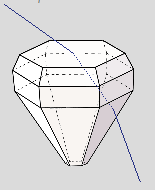23° Upper Pyramidal Arc
Exploring the 23° Upper Pyramidal Arc: A Spectacular Atmospheric Phenomenon
Have you ever looked up at the sky and been captivated by the beauty and wonder of atmospheric optics? One such phenomenon that can leave you in awe is the 23° Upper Pyramidal Arc. This bright and colorful arc, often seen alone in the sky, is a sight to behold. In this article, we will delve deeper into this fascinating atmospheric phenomenon and uncover its secrets.
The 23° Upper Pyramidal Arc is a halo that can be observed under specific atmospheric conditions. It was first documented on July 5th, 2000, in Norfolk, England. During this time, the sun was at an elevation of 28-22°. The arc appeared above the horizon between 16:55 and 17:35 UT, creating a breathtaking spectacle for those lucky enough to witness it.
When examining images of the 23° Upper Pyramidal Arc, one might notice a faint circular halo beneath it. This additional halo adds to the complexity of the phenomenon. Some experts believe it could be either a 23° or 22° halo. Determining the exact nature of this circular arc has proven challenging, but ongoing research and analysis are shedding light on its origins.
To understand the formation of the 23° Upper Pyramidal Arc, we must examine the path of light rays through specific ice crystals in the atmosphere. These crystals have a pyramidal shape with their large end pointing downwards. When sunlight enters the crystal through its near-horizontal top face, it exits through one of the lower pyramidal faces. This unique ray path creates an "efficient" process that generates a bright and distinct arc.
Although the 23° Upper Pyramidal Arc may appear fragile and delicate, it can withstand considerable crystal tilts from the vertical position. This resilience contributes to its visibility and longevity, allowing observers to marvel at its brilliance for extended periods.
Researchers and atmospheric optics enthusiasts have debated whether the 23° Upper Pyramidal Arc should be classified as a pyramidal crystal phenomenon or a Parry arc. The HaloSim simulation, which includes pyramidal crystals and Parry-oriented columns, suggests that the 23° parhelion best matches the photographs and visual appearance of the phenomenon. This ongoing discussion highlights the intricate nature of atmospheric optics research and the dedication of scientists in unraveling its mysteries.
In conclusion, the 23° Upper Pyramidal Arc is a captivating atmospheric phenomenon that enchants viewers with its vibrant colors and intricate structure. Its presence in the sky, often seen alone, adds an element of uniqueness to its allure. Understanding the formation of this arc requires careful analysis of the path of light rays through specific ice crystals. Ongoing research continues to shed light on the exact nature of this phenomenon, contributing to our knowledge of atmospheric optics and the wonders that await us above. So, keep your eyes to the sky and be ready to witness the awe-inspiring beauty of the 23° Upper Pyramidal Arc.

Lone Arc. This bright and colourful arc was the only halo apparent in the sky ~ Norfolk, England 5th July 2000, 16.55 - 17.35 UT sun 28-22� high. The image, however, also shows a faint circular halo beneath the arc. Image �2000 Les Cowley.

Pyramidal 23� upper parhelion or Parry arc? The HaloSim simulation includes pyramidal crystals and Parry oriented columns. Both arcs are similar but the 23� parhelion best matches the photographs and visual appearance. The very faint circular arc could be a 23 or 22� halo. Thanks to Walter Tape and Jarmo Moilanen for help with the identification.

Ray path for 23� upper parhelion. The crystal is oriented with its large pyramidal end pointing downwards. Rays enter the near horizontal top face and leave through one of the lower pyramidal faces. The path is very 'efficient' and generates a bright arc which survives quite large crystal tilts from vertical.
Note: this article has been automatically converted from the old site and may not appear as intended. You can find the original article here.
Reference Atmospheric Optics
If you use any of the definitions, information, or data presented on Atmospheric Optics, please copy the link or reference below to properly credit us as the reference source. Thank you!
-
<a href="https://atoptics.co.uk/blog/23-upper-pyramidal-arc/">23° Upper Pyramidal Arc </a>
-
"23° Upper Pyramidal Arc ". Atmospheric Optics. Accessed on November 14, 2024. https://atoptics.co.uk/blog/23-upper-pyramidal-arc/.
-
"23° Upper Pyramidal Arc ". Atmospheric Optics, https://atoptics.co.uk/blog/23-upper-pyramidal-arc/. Accessed 14 November, 2024
-
23° Upper Pyramidal Arc . Atmospheric Optics. Retrieved from https://atoptics.co.uk/blog/23-upper-pyramidal-arc/.